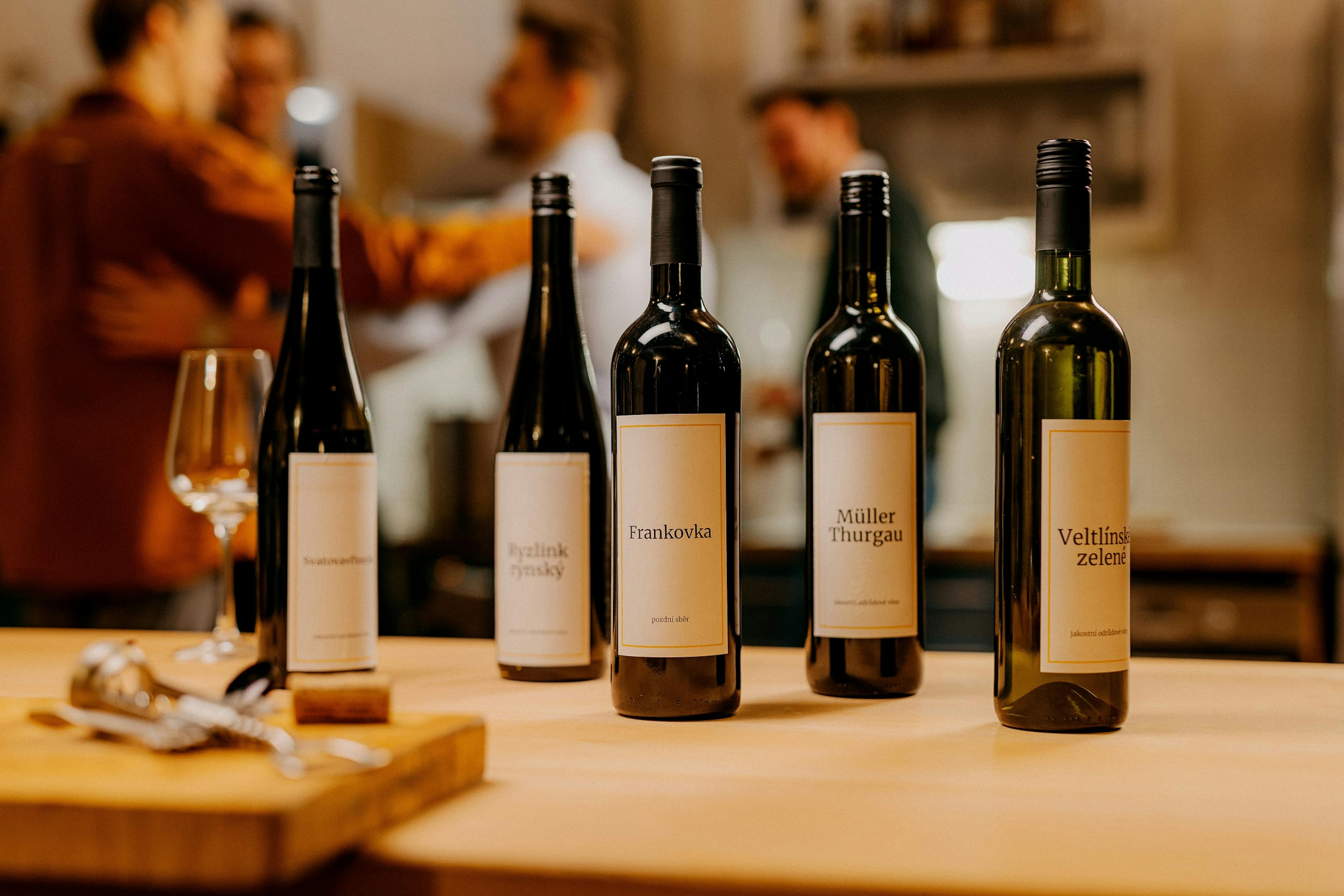Character and Attributes of Moravian Wines
How does one describe Moravian wines? As quite original without a doubt… Even through the comparatively effortless orientation in Moravian and Bohemian wines is their unrivalled diversity, which when compared on a world scale is quite unbelievable and unique. Over fifty grape varieties are cultivated in the Czech Republic, which guarantees that everyone is bound to find a favourite here. A whole range of varieties has also been bred and developed in this country, so ensuring that they flourish here and give wine of the very best quality. The exceptional range is even appreciated year after year by tasters in wine competitions around the globe.
In our territory, similarly to in Austria and Germany, we adopted the system of classifying the quality of wines according to the sugar-levels of the grape must at harvest. The better the vintage and the better the vintner cares for his vineyard, the better the grapes will ripen and consequently will contain higher levels of natural sugar. Thus special selection of grapes is then a wine from riper and more sugar-rich grapes than a simple quality wine.
A sense of “terroir” is distinctly projected onto the wine’s palate. This means the specific natural conditions in combination with the varietal composition and human touch in a clearly defined geografical area which makes a wine from a specific place unique and characteristic.
And what are the typical attributes of Moravian wines? Their crispy freshness, a ripe and juicy acidity on the palate, an abundance of extractive substances, a pronounced aroma full of delicate tones – all this can be found in Moravian wines. The doyen of Moravian viticulture, Professor Vilém Kraus once said of this: “Without the basic character being suppressed, the attributes of Moravian wines come from their immense diversity based on the great number of grape varieties cultivated here. This diversity is however also influenced by a great articulation of the soil and gives to the individual, omnipresent varieties its expression in the final character of the wines based on the conditions prevailing in the Moravian bio-regions. Sameness in wines from Moravia is thus excluded, provoking an inquisitiveness which can never be fully satisfied.”
Sub-Chapter BIO-REGIONS (Professor V. Kraus, CSc.)
The Lechovice bio-region covering the area of Znojmo, where the outstanding individual vineyards can count on a very warm mezo-climate with a rain shadow from the Czech-Moravian highlands, from where the cold highland air occasionally descends thus retarding the vegetative cycle. The slow ripening of the grapes increases the content of aromatic substances of the primary type. Geological and soil conditions divide the vineyard tracks into typical patches. In the Znojmo area there is the rocky Dyje massif with granite and granitoids, which have a low calcium, potassium and phosphorus content. Such conditions are mainly suited to white grape varieties with the Riesling and Sauvignon Blanc standing in the forefront. To the south of Znojmo are the massive drifts of loess which are well-suited to Müller-Thurgau, Pinot Blanc and the most planted grape variety Grüner Veltliner. In the Miroslav-Krumlov area the vineyards lie on the narrow strip of Moravika which has a greater proportion of slate, and where conditions are good for Riesling, Grüner Veltliner, Pinot Gris. In the Dolní Kounice enclave black grape varieties are traditionally to be found on the neutral or acidic soils with tighter, but markedly spiced flavours, especially present in the highly reputed Frankovka (a.k.a. Blaufränkisch or Lemberger) of Dolní Kounice. The Hrušovany area which is rich in sandy soils is suitable not only for Grüner Veltliner but also for Welschriesling and Pinot Gris.
The Mikulov bio-region is the most typical of the Pannonian bio-regions, in which the formation of Pálava hills stands out from the Mikulov uplands like a cliff which is formed by Jurassic limestone, surrounded by Cretaceous sediments and with local representation of loess. The range of varieties for making white wine predominates. The higher calcium content in the soil in these very warm vineyard tracks give the white wine a special type of robust but clearly defined minerality. This is mainly evident in the Chardonnay, Pinots Blanc and Gris, Welschriesling and also Aurelius varieties. Grüner Veltliner thrives in the deep loess soils while the gravelly patches found locally on the Dunajovice heights are suitable for black grape varieties. Heading towards the east is the Valtice upland stretching out with its heavy earthy soils suitable for a wider varietal spectrum. This changes on the sandy plateau of Boří forest, where Riesling, Pinot Blanc and the black grapes give of their best.
The extensive Hustopeče bio-region covers the Hustopeče-Kyjov upland and the spur of the Ždánice forest as well as the Oligocene Chřiby mountains. It stands on calcareous flysch and on loess. Pannonian and Carpathian elements intermingle in this bio-region. Hillside positions appear in the southern segment of the Lower Moravian plain, following alongside a stretch of the Brno – Břeclav motorway, washed by accelerating warm winds. On the earthy and loess soils hereabouts are excellent conditions for Grüner Veltliner, Riesling, Pinot Blanc, Gewurztraminer and for a rich selection of black varieties. The interior part of the hilly land is at a higher altitude and the cooler mezo-climate accentuates the acidity content of the refreshing white wines, in particular those from the Müller-Thurgau grape variety. This bio-region comprises the vineyards of Hustopeče, Velké Pavlovice, Mutěnice and Klobouky. As opposed to the other bio-regions, here there has been a long tradition of planting black varieties for making red wine, most especially Blaufränkisch (Lemberger), Saint Laurent and Blauer Portugieser. This is also a cradle of a brand once known as “Slovácko Garnet”, a blend of the Blaufränkisch and Blauer Portugieser grape varieties. The red-wine quality is encouraged by the high magnesium content in the local soils. Also the Neuburger and Pinot Blanc varieties have long ruled on the loess here.
The lowland section of Podluží, with its warm, dry climatic conditions and more frequent inversions belong to the Dyje-Morava (March) bio-region. The sandy soils of the flat plateau are well suited to the black varieties Zweigeltrebe, Blauer Portugieser, Blaufränkisch (Lemberger) and the grape variety created here – Cabernet Moravia. On the short slopes the conditions favour Riesling, Sauvignon Blanc, as well as the Pinot family.
The low-lying segment of eastern Mutěnice belongs to the Hodonín bio-region as do the flatlands to the south of Bzenec and Kyjov. Above this plateau, which borders the River Morava (March) to the east, lies the Náklo elevation where the vineyard slopes of Dubňany, Vacenovice and Milotice are to be found. The northerly part belongs to the Ždánice-Litenčice bio-region, where it comes under the influence of the geomorphology of the Carpathian system. It is a region for white wines with pronounced aromatic substances of the primary type. Riesling too gives good quality wines, well-known in Bzenec under the name of Lipka (Lime tree). Apart from Müller-Thurgau we also have here Pinots Blanc and Gris while for the production of red wine Pinot Noir predominates. The vineyards of Uherské Hradiště, where the warming effect of the south-lying Pannonian influence wanes and disappears, are also part of this bio-region. Apart from the Burgundian varieties, Müller-Thurgau as well as Moravian Muscat produce highly attractive wines.
From the shores of the River Morava (March) the Hluk bio-region extends along the foothills of the White Carpathians. The sub-soils of the vineyard tracks of Strážnice and Blatnice date back to the Eocene era, from the overlying chalk or else are formed from a powerful layer of flysch. The climate of the Hluk bio-region is influenced by the warm dry climate of the neighbouring North-Pannonian sub-region. The positive influence on the ripening of grapes is due to the warm wind – föehn – which blows across the spine of the White Carpathians during the ripening period where it dries up and warms the vines upon descending. A considerable part of the vineyards lie on the hard soils formed from autochthonous clay. These soils are water-retentive and the vines on them derive nourishment from this in the course of drier years. This adds extract and fullness to the local wines. It is a region primarily known for its white wines from the Burgundian varieties, Riesling and also the once-extensively cultivated Sylvaner. The locality of Roháče in the Blatnice area gave us the famed wine “Blatnický Roháč” – originally a blend of Sylvaner and Pinot Blanc, and possibly also Riesling.
The above-mentioned bio-regions are, with their varied soil conditions and specific mezo-climates, the essence of the basic division of “Moravian wines” into natural territorial units within the environment and the character of the wines that emanate from them. This alliance forms the typical terroir of the regional whole and is currently the pre-requisite for a higher quality level in the wines emerging from the diverse conditions of the given bio-regions. At the same time this natural alliance among the varieties and the ecological characteristics of the environment should serve as the foundation for the creation of the VOC wines of protected origin by the vintners’ associations as a part of the overall territorial whole of MORAVIA.
The lesser the territorial area from which wine from specific grape varieties in a specific bio-region is made each year, the better pre-conditions exist for excellent quality. And that is why the first-class vineyard track, with its precisely defined topographical and soil conditions, planted with appropriate varieties, cultivated by the proper agricultural means, is the pinnacle synthesis of natural energy and the winemaker’s art.



